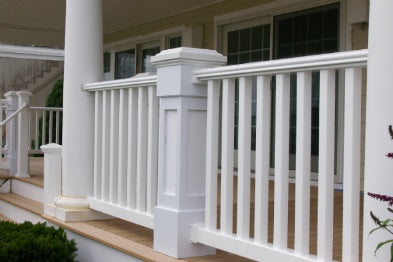When adding a railing system to a porch or deck, it is important that climate is taken into consideration when choosing the material for your railings. This is particularly critical in colder climates, as extreme temperature fluctuations and moist weather conditions can wreak havoc on certain building materials. Choosing a durable railing material is particularly critical in areas that see harsh winters, as railings can provide the safety and stability needed to prevent accidental injuries, and potentially fatal falls, when there is snow and ice on the ground.
Ultimately, in cold climates, you will need to look for a building material that will be able to withstand the elements, as ice, moisture, and salt can be pretty destructive if you choose the wrong railings for your project. The fact is that the salt we use to de-ice roads and sidewalks, as well as water from melting snow, can cause certain materials to corrode. This can cause newly installed railings to quickly become a safety hazard if they lose their structural stability. To help ensure that you choose the right railings for your cold-weather deck or porch, here is an overview of what you need to know about the most common outdoor railing materials.
Wood
Wood is a popular choice for railing construction due to its low price point and versatility. However, when used for exterior railings, wood can pose several problems due to the fact that it decays quicker, and will have to be replaced more frequently, than other building materials. Wood porch railings are particularly problematic in cold climates, as ice and snow melt can soak into the wood during winter causing your railings to warp and rot. Additionally, water can get into crevices in the wood and freeze, causing the material to expand and separate, which can make your railings unstable. Ultimately, while wood can be a good option for interior railings, or for exterior railings in dry, warm climates, you will want to avoid wood for cold weather porch or deck railings.
Aluminum
A better option for exterior railings in cold climates would be aluminum railings, as aluminum is extremely long-lasting, and it is durable enough to withstand anything that even the harshest winters throw at it. Aluminum surfaces will not rust or corrode, and they will be able to provide strong support year-after-year. Aluminum deck railings can be made even more durable with the addition of a powder coating that will help it to better withstand exposure to corrosive salt in the winter. The primary downside of using aluminum for exterior railings is that metal tends to get extremely cold, which can make them uncomfortable to hold onto during the winter months.
PVC
Another popular option for exterior railings are those made out of molded PVC. Like aluminum, PVC railings will not warp, rust, corrode, or decay even when exposed to the harshest weather conditions. These railings also stand up well when exposed to salt, and they have outstanding cold temperature impact resistance. A benefit PVC provides over aluminum is that these railings do not get as cold, making them more pleasant to grab onto at night or in winter. PVC railings are able to withstand the elements as well as the test of time, which is why they are quickly becoming one of the most popular exterior railing systems for both commercial and residential use.
Choosing the right exterior railings for your project can help to reduce maintenance requirements, and it will help to ensure that your railings are able to withstand even the harshest of winters without breaking down. Contact us to learn more about what railing system would be best for your cold-weather porch or deck.


